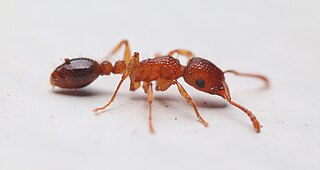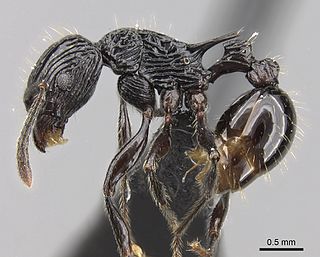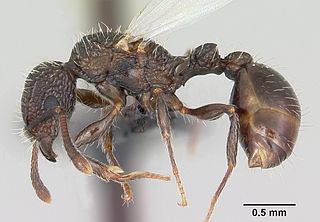
Tetramorium immigrans—also known as the immigrant pavement ant, pavement ant, and the sugar ant in parts of North America—is an ant native to Europe, which also occurs as an introduced pest in North America. Its common name comes from the fact that colonies in North America usually make their nests under pavement. This is one of the most commonly seen ants in North America, being well adapted to urban and suburban habitats. It is distinguished by one pair of spines on the back, two nodes on the petiole, and grooves on the head and thorax.

Tetramorium inquilinum is an ectoparasitic ant found in Europe. It was discovered by Swiss myrmecologist Heinrich Kutter. The species is unusual for lacking a worker caste, the queens and males living entirely off the care of the pavement ant. It has been called "the 'ultimate' parasitic ant" by myrmecologists Edward O. Wilson and Bert Hölldobler.

Tetramorium is a genus of ants in the subfamily Myrmicinae that includes more than 520 species. These ants are also known as pavement ants.

Tetramorium caespitum, also known as the pavement ant, is a species of ant in the family Formicidae.

Tetramorium insolens is a species of ant in the genus Tetramorium. It is a medium-sized orange ant that is mainly seen on vegetation, has a monomorphic work caste with 12-segmented antennae, three-segmented antennal club, short antennal scapes that do not surpass the posterior margin of the head, a gradually sloped mesosoma, and strong propodeal spines. It has two waist segments and a gaster with a stinger.

Tetramorium bicarinatum, is a species of ant of the family Formicidae in the order Hymenoptera that originated in South East Asia.

Tetramorium nazgul is a species of Myrmicine ant native to Analalava, Ambohijanahary, and the Zombitse-Vohibasia National Park, Madagascar. The species is characterized by long, thin, propodeal spines. Its body is covered in a multitude of long hairs. General coloration is dark brown or black, with lighter coloration on the legs. The species is commonly found in leaf litter in tropical dry forests and montane rainforests, typically around elevations of 700 to 1,100 meters. It was named after the Nazgûl from J. R. R. Tolkien's The Lord of the Rings.

Tetramorium smaug is a species of myrmicine ant native to Ambatovy, Amber Mountain National Park, and Ivohibe in Madagascar. It was found in montane rainforests around elevations of 900–1,300 metres (3,000–4,300 ft). It is believed to live in vegetation as opposed to on the forest floor. Coloration is dark brown or black. The head and mesosoma have rough surfaces while the gaster is smooth. The head has a large number of hairs, but the amount of hair decreases on each segment posteriorly. The species has long propodeal spines with a broad base. It was named after the dragon Smaug from J. R. R. Tolkien's novel The Hobbit.
Tetramorium curvispinosum is a species of ant in the subfamily Myrmicinae. It is found in Sri Lanka.

Tetramorium pacificum, is a species of ant in the subfamily Myrmicinae. It is found in many countries.
Tetramorium pilosum, is a species of ant in the subfamily Myrmicinae. It is found in Sri Lanka, and China.

Tetramorium tonganum is a species of ant in the subfamily Myrmicinae. It is found in Australasian, Indo-Australian, Oriental, and Palaearctic regional countries.
Tetramorium tortuosum, is a species of ant in the subfamily Myrmicinae. It is found in Philippine, India, and Sri Lanka.
Tetramorium transversarium, is a species of ant in the subfamily Myrmicinae. It is found in Sri Lanka.
Tetramorium yerburyi is a species of ant in the subfamily Myrmicinae. It is found in Sri Lanka and China.

Tetramorium hispidum is a species of ant in the subfamily Myrmicinae. Tetramorium hispidum differs from similar ants in the Myrmicinae subfamily by the structure surrounding the ant's antennal insertions. Short, stubble-like hairs exist on the pronotum and frontal carinae. The antenna of Tetramorium hispidum contains 11 segments.
In ecology, a tramp species is an organism that has been spread globally by human activities. The term was coined by William Morton Wheeler in the bulletin of the American museum of natural history in 1906, used to describe ants that “have made their way as well known tramps or stow-aways[sic] to many islands The term has since widened to include non-ant organisms, but remains most popular in myrmecology. Tramp species have been noted in multiple phyla spanning both animal and plant kingdoms, including but not limited to arthropods, mollusca, bryophytes, and pteridophytes. The term "tramp species" was popularized and given a more set definition by Luc Passera in his chapter of David F William's 1994 book Exotic Ants: Biology, Impact, And Control Of Introduced Species.










